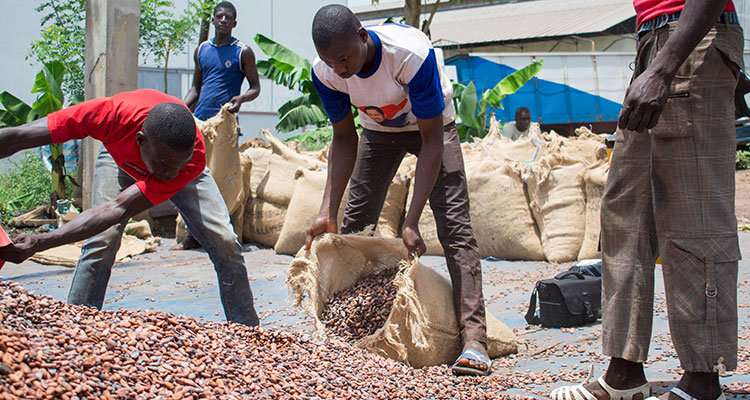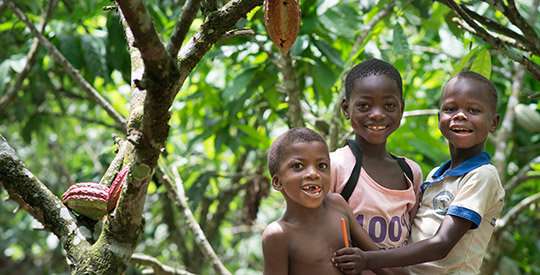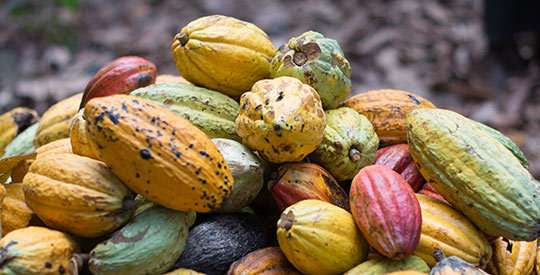Sweetening the chocolate deal: the ECOLIMITS project is looking into sustainable cultivation of the cocoa crop. Credit: PlanetEarth Online
Chocolate may be one of life's little pleasures, but in Ghana, for many, it is the very means of life. Around 800,000 households, smallholdings effectively, make their way by cultivating cocoa, and many more are involved in the supply chains that bring it to our supermarket shelves.
The industry accounts for a quarter of Ghana's foreign earnings, but it is vulnerable to climate change and environmental degradation, and has been associated with widespread deforestation.
The ECOLIMITS project has been looking into sustainable cultivation of the crop.
Making cocoa work for its often small-scale producers
"There is a huge potential for expanding cocoa production," said Dr. Rebecca Ashley Asare, Director of Programmes & Research at the Ghanaian Nature Conservation Research Centre, one of the partners in the collaboration. "Productivity per hectare can be very low, so there's a big conversation about how to improve farmers' yields, and so raise household incomes."
The industry is mostly small scale—cultivated on plots of just a few hectares, alongside palm oil and food crops. For the households in the near-coastal region studied by the ECOLIMITS team, the beans they sell to local merchants can make up 70% to 90% of their income.
As a result, raising yields can go a long way to alleviating poverty. Equally, any failure exposes those on the borderline to catastrophe.
The El Niño effect on a fragile system
Despite the industry's global scale, poverty is still a problem for Ghanaian cocoa farmers and their families. But raising yields can raise incomes. Credit: PlanetEarth Online
Not long after the teams had completed their first survey of 108 households in the area, the powerful El Niño of 2015-16 set in, underscoring the crossplay of ecology and vulnerability the project was intended to untangle. Those old enough to remember did not recall a drought as severe since 1982-83—again brought about by an El Niño climate swing.
'Fragile' was the word used by graduate team member, Victoria Maguire-Rajpaul. "The drought exposed the vulnerability," she said she concluded, when the team made its second survey in 2016 with additional support from NERC's El Niño impacts fund. "Botanically the system is fragile, and the farmers' lives are also fragile."
Although healthy cocoa plants tended to ride out the resulting deepened and prolonged dry season, subsistence crops did not. The poorest households, lacking insurance or access to banks, were driven into the hands of lenders who could charge loans at 100% interest. What sometimes followed, the researchers learned, was loss of land under the local tenanting arrangements.
Better yields
Improved management could make the difference. "We're not talking about intensification, in the sense of more trees per hectare," said Victoria Maguire-Rajpaul. Nor is expansion an option. After decades of deforestation, Ghana is committed to the international REDD+ conservation scheme, which rewards stakeholders for avoided carbon emissions.
Yields average (median) around 890kg per hectare of beans, according to University of Oxford's Alexandra Morel, but can be up to 3,000kg, or as low as 20kg per hectare. In part the variation is explained by a household's dependence on the crop, but a host of other factors are also important.
The study strategy was to look at smallholdings within 100 metres of the Kakum forest, and compare them with those 500 metres, a kilometre and 5 kilometres from its edge. Wherever they looked, the biggest driver of yield was artificial fertiliser, which may seem obvious but is in fact deeply significant. The Ghanaian government has had a policy of providing fertiliser free to cocoa plantations, but has applied the policy erratically. "Only consistent application will yield benefits", Alexandra Morel explains.
The project also found a clear trend of lower yields further away from the forest.
Need for trees
The delicate cocoa crop is easily affected by changes in weather and is susceptible to diseases and pests. Credit: PlanetEarth Online
"Experienced farmers clearly understand the value of the native trees," said Victoria Maguire-Rajpaul. "The cocoa plants thrive in shade." Alexandra Morel adds that the results give farmers a stake in preserving the forest in the Kakum National Park where the ECOLIMITS study took place.
Farmers can, and do, replicate some of the benefits of the forest by planting or retaining the tall native trees on their plots, providing much needed shade to the cocoa trees. But here again, issues around ownership can be a disincentive. The timber locked up in those trees is valuable, but will not necessarily belong to the farmers who planted them. Attempts by the EU to promote legal timber may even have backfired, the researchers suggest, by putting formal permits beyond the reach of the poorest smallholders.
In its three years, ECOLIMITS revealed a tangled web of ecological and sociological factors that need to be negotiated if the benefits of cocoa cultivation are to penetrate to the most vulnerable families. But the quest has been rewarding. "Ghana is a dream to work in," Alexandra Morel said. "We formed strong partnerships with the local scientists, who were very welcoming and engaged. We'd really like to continue the work."
Rotten solution
Heaps of rotting plantain were one strategy unveiled by the ECOLIMITS researchers. Pollinators were scarce but the tightly closed petals of the cocoa flower allow entry to only the smallest insects, midges, whose range is limited. They found flowers were more likely to be pollinated where they had compost, which was a puzzle.
Although ECOLIMITS was not intended as an experimental programme, experiment they did, finding that a pile of decomposing banana stems was just the thing to boost the midge supply. "After fertiliser, these compost heaps proved to have the greatest effect on yields. It was a surprise to us," said Alexandra Morel.
Provided by PlanetEarth Online
This story is republished courtesy of Planet Earth online, a free, companion website to the award-winning magazine Planet Earth published and funded by the Natural Environment Research Council (NERC).

























